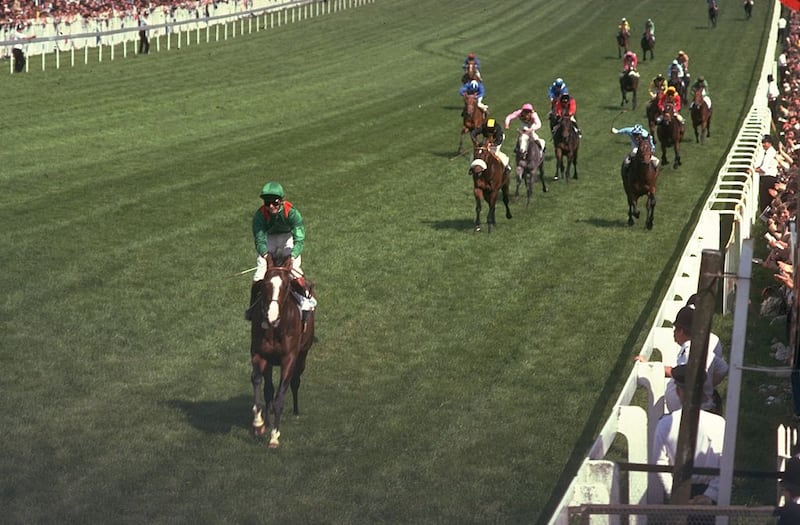In February 1994, James Cosgrove wrote a letter to insurance company Norwich Union.
The Cosgrove family, through James’s father, Stan, had owned a share in the Irish thoroughbred stallion and Epsom derby winner Shergar and was hoping to recover an insurance payment.
The Cosgroves were highly respected in Irish racing and Stan, an eminent equine vet, was manager of Moyglare stud and a director at auction house Goffs.
James had written the letter because more than 10 years earlier, at 8.30pm on the evening of February 8th, 1983, at least four masked and armed raiders arrived at Ballymany stud farm in Kildare.
Cheltenham: Lossiemouth switched from Champion Hurdle to defend her Mares' Hurdle crown instead
JP McManus: From fearless young punter to Cheltenham’s most successful racehorse owner
Malachy Clerkin: Cheltenham’s thrill is gone as the best stories are replaced by the betting, the betting, the betting
Will Willie Mullins, with nothing left to prove, bow out after Cheltenham? Don’t bet on it
The Fitzgerald family, who resided in the stable yard where Shergar was kept, were held at gunpoint and James Fitzgerald, along with the horse, were taken. Fitzgerald was later released on an isolated road, shaken but unharmed.
Shergar was a highly valuable animal. In 1981 he had run in six races, winning five, including the Irish Derby, King George VI, Queen Elizabeth Stakes, and at Epsom won by a record 10 lengths.
Before leaving the farm, the men indicated there would be a ransom of £2 million sterling and when contact was made, they would use a code name “King Neptune”.
The ransom was a fraction of the horse’s worth. The Ballymany stud was owned by one of the titans of the racing industry, billionaire and spiritual leader the Aga Khan, who died this week aged 88.
Shergar, however was syndicated out after the Epsom Derby win, and the Aga Khan sold many of the 40 shares in the horse, which valued it at £10 million.
The ownership broke down into 29 units of one share, two units of a half share each, one unit of four shares and one unit of six shares. Cosgrove had borrowed £155,000 in 1982 as a down payment on the £250,000 cost of his share.
However, the insurance company would not pay out because, among several issues, they said that although the stallion had obviously been taken and was missing, they could not verifiably know that it was dead. There were no remains.

It was then a Belfast-born Dubliner called David Horgan, who knew Stan Cosgrove through working at Goffs, became involved.
Horgan came from the Springfield Road area of West Belfast, was a Cambridge law graduate and studied at Harvard. Seeking to establish that the horse was no longer alive, he wrote a letter to Maghaberry Prison, located just outside Belfast and asked to speak to a senior member of the IRA called Sean O’Callaghan who was incarcerated there.
O’Callaghan, who came from Tralee, was an IRA member between 1970 and 1985 and a Garda informant from 1979 to 1985. He died in 2017 by drowning after suffering a heart attack at the age of 63 while swimming in Jamaica.
O’Callaghan was receptive to talking to Horgan, who travelled up to the “supergrass” wing of Maghaberry on February 18th, 1993. There O’Callaghan told him that Shergar had died shortly after the kidnapping 10 years previously.
In criminal terms, the kidnap was an innovative idea, although it did not work out as planned. Security at the stud farm was not tight and the shareholders were seen to have deep pockets.
The team planned the venture using an individual with horse knowledge and acted at the beginning of the breeding season. Since the breeding window was limited, the incentive would be to settle quickly.
“In practice it didn’t work,” says Horgan. “They got a guy from Kill, who was supposed to be a ‘horsey’ person. But to control a stallion who has been taken away from his handler . . . he lost control of the animal. His abductors stopped several times on route to Leitrim to calm the stallion. Eventually Shergar injured his leg from kicking, which aggravated his frenzy.
“Without veterinary expertise the kidnappers had to destroy the great racehorse and disposed of the body. It was buried on the Leitrim/Fermanagh border near an area called Aughnasheelin.
“People have called O’Callaghan a fantasist,” he says. “But I think that’s unfair. He wasn’t a bullshitter. He’d nothing to gain. He didn’t ask for anything. I didn’t give him anything.
“When he gave me details of what had happened, he told me what he knew, how he knew it. When we veered off on anything he didn’t have direct knowledge of he said: ‘I really don’t know that.’ To me that gave him credibility, a guy who admits when he doesn’t know.”
[ Aga Khan dies with mystery of Shergar kidnapping still unsolvedOpens in new window ]
O’Callaghan was asked to sign a written statement. He agreed. It said: “I was a senior IRA volunteer from 1970 to 1985 as well as a Garda Síochána informant from 1979 to 1985. Acting on Garda requests as well as my own initiative, I investigated the Shergar kidnapping in 1983. The clear and consistent statements of those directly involved was that the horse was shot in February 1983. I informed the Garda accordingly at the time. Since the kidnappers were never convicted of that offence, they are unlikely to offer sworn evidence for a civil action.”
Horgan also received a signed statement from a senior garda saying they had intelligence that the horse had become distressed and had been destroyed.
In a letter to James Cosgrove dated January 18th, 1993, an official handling the case for the insurer was adamant no payment would be made. “I am sure you would not expect me to accept comments made by a known terrorist as being irrefutable evidence that Shergar was killed within the currency of the policy,” he said. “I certainly have no intention of making any payments under the terms of this contract.”
Stan Cosgrove, who died in 2019, never did get his insurance money and Shergar’s body never was recovered. In an act of generosity, the Aga Khan declined further payment for the Cosgrove share, which he was contractually entitled to.
Like the disappearance of Lord Lucan, the final resting place of Shergar remains one of the great Irish mysteries – that is unless you believe the words of a deceased IRA volunteer and a highly ranked member of An Garda Síochána.
- Listen and subscribe to our Counter Ruck rugby podcast
- Sign up for push alerts and have the best news, analysis and comment delivered directly to your phone
- Find The Irish Times on WhatsApp and stay up to date


















